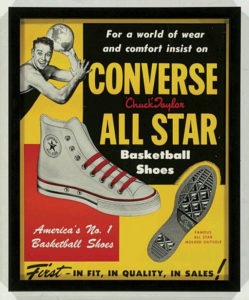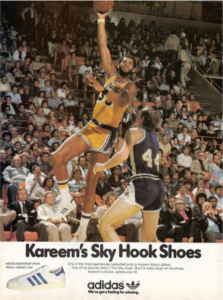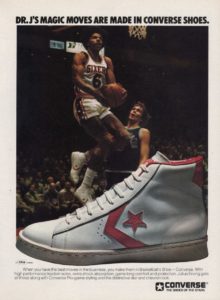The Converse Chuck Taylor All Star: probabilistically speaking, there’s a good chance you’ve worn a pair at some point in your life, or at the very least have known someone that rocked these classic sneakers. The Chuck Taylor has been around seemingly forever – before Nike, before shoe endorsement deals and celebrity-designed drops. This unassuming shoe has lived many lives over its century of existence, and been worn by everyone from influensters and professional basketball players to your mom and the Vice President. The history of this canvas legend is a twisting tale, woven into the fabric of sports, commerce, and culture.
Like most great stories, the Chuck Taylor All Star comes from humble beginnings. Founded in 1908 by Marquis Mills Converse, the Converse Rubber Company was much like any other New England rubber producer of the era. Producing a smattering of everything rubber-related, they briefly made automotive tires, hunting boots, galoshes and tennis shoes.
While one might hope that a design as ubiquitous as the All Star was born through careful design and innovation, the truth is a bit more boring. For the first decade of Converse’s existence they kept a short staff through the summer months as a cost saving measure. But Converse wanted to find ways to keep employees on throughout the year, so they decided they needed to introduce a new product for the fall season that would require they keep their production line open. Lucky for them, they were somewhat close to the town of Springfield, Massachusetts, where a graduate student named James Naismith had some years before invented a new pastime called “Basket Ball.”
They’re Playing Basketball
Invented as an indoor sport to be played during the offseason of the more popular sports, basketball had been around for nearly 25 years by the time Converse came knocking. The company recognized the potential of this untapped pastime, as it was slowly starting to gain traction with players across New England. While several different local mills had produced some shoes that were meant for the game, Converse set out to be the first to make a big effort to be the only shoe on the court.
Released in 1916, this debut line from Converse featured a handful of somewhat similar designs, all with somewhat basketball-related names like the “Big Nine” and “Surefoot.” One design did catch on though, the “Non-Skid.” The Non-Skid was a hi-top sneaker with an off-white canvas upper and a specially-designed sole for traction on the court, the classic diamond tread. A silhouette that is easily recognizable today, the Non-Skid also featured a leather ankle patch, designed to protect players’ ankles, and an interior heel patch for stability and heel protection.
Converse needed to get these new shoes on the court, so they built a brand-sponsored basketball team – the All Stars. To maximize hype, they hired a coach and salesman that had dabbled with the sport in his college years to guide the team on this journey, Charles “Chuck” Taylor. A natural salesman, Taylor would offer post-game coaching clinics, where he would go over the fundamentals of the game in an effort to not only spread the sport of basketball, but also to ensure the sport was synonymous with Converse shoes. According to the Converse archives, he would baldly suggest coaches use only Converse shoes, even going so far as to walk down to nearby shoe stores with players and coaches to oversee their purchase of Converse shoes.

As this was over a hundred years ago, Converse also had to make sure their print marketing game was strong, so they published an annual Converse Basketball Yearbook. Operating as essentially a catalog, the Yearbook would have images of teams, players and coaches (all conveniently wearing Converse shoes) mixed in with basketball tips and tricks. While these two marketing methods might seem laughable today, they were incredibly effective. By the time the Depression hit, the Non-Skid was the basketball shoe – worn by everyone and wildly popular.
In recognition of the hype team, Converse renamed the Non-Skid the All Star. They also sought out player feedback, reengineering the shoe to introduce the pivot button (aka the reinforced area of the sole under the ball of the foot), so players could pivot on a dime. The playstyle of basketball was getting quick and players needed shoes that could keep up. As the sport spread, growing ever more popular each year, Converse sought to acknowledge the man that made it all possible by dubbing the All Star the “Chuck Taylor,” in honor of his contributions to the brand and to the sport. While not as flashy as the sneaker deals in the decades to come, emblazoning shoes with Taylor’s name might be the very first sneaker endorsement deal.
By the start of World War II, basketball had become quite popular across the East coast. And as basketball’s popularity grew, so too did that of Converse. Forward to the establishment of the National Basketball Association in 1946 (then named the Basketball Association of America), and Converse was essentially the unofficial sneaker of the sport, as nearly every player on the court laced up a pair of All Stars. For the next twenty years Converse served as the King of basketball shoes, the two exploding in popularity by the time the 70s crept around.
Getting Benched
You can’t stay king forever, though. Converse sold millions of All Stars and reigned supreme on the court until the 1970s, when shoe technology improved closer to what we might consider a “modern basketball shoe” and several newer entrants took on the basketball shoe market – including Puma (who signed Walt Clyde Frazier) and Adidas (who signed Kareem Abdul-Jabaar).

By the end of the 70s, the All Star had all but disappeared from arenas. Converse was still a major player in the basketball shoe market with their Converse Pro Leather, worn by Dr. J and later Larry Bird, but the company was no longer the totally dominant force on the court it had once been.
Through the mid 80s Converse continued to have a respectable share of the basketball shoe market, but by the time Nike released the Air Jordan I in 1985, it was clear that there was a new (sneaker) king on the court. In a last ditch effort to remain in the game, Converse dropped the Weapon in the 1980s, heavily marketing it with the help of Bird and Magic Johnson. Still, by the early 90s, Converse had become a marginal player in the sport, despite the fact that basketball had become a cultural phenomenon.

The New Era
While Converse may have lost the battle over basketball, the All Star itself was not going down without a fight. The Chuck had always been an affordable shoe, and now that it was produced in different colors and no longer widely considered a basketball shoe, the style found life with non-athletes. Punks customized them in the 70s, metalheads and grunge bands wore them until they fell apart in the 80s and 90s. Emo kids turned them into art projects in the early 2000s and teenagers to this day customize them online.
Converse never found their way back into starting lineups, as Nike became the go-to brand for basketball shoes after a flashy series of marketing moves. However, one might argue that His Airness himself, Michael Jordan, may not have had his eponymous sneaker endorsement without Chuck Taylor slinging shoes and blazing trails a half century earlier.
Today, despite its basketball downfall, the All Star is still a bona fide classic. In the decades since the All Star retired from the court, the style has only grown in popularity, as it seems like nearly every company has produced styles inspired by the unmistakable silhouette, from Rick Owens’ luxurious take on the classic black colorway to R13’s platform version of the high-top. In recent years, Converse has collaborated with just about every brand, artist and maker under the sun to produce special edition All Stars.
The legacy of the All Star casts a long shadow. Not only is it still a popular shoe to this day, but it is arguably the grandfather of sneaker culture and the brand responsible for assisting basketball in getting into the mainstream. Without the early marketing attempts by Converse to sell their shoes by promoting the sport of basketball, the sport as we know it may have not developed so quickly – or at all. And without the power of hype deployed so cleverly by Converse, sneakerhead culture might never have found traction.
No longer king of the court, the Chuck Taylor All Star is nevertheless a sneaker legend.

